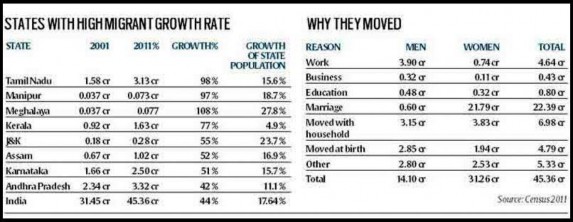As per Census 2011:
MIGRATION patterns in India are increasingly reflecting the economic divide in the country, with more migrants over the last decade heading to the southern states, which have grown at a faster clip during this period.

♤ Tamil Nadu’s migrant population surged 98 per cent from 1.58 crore in 2001 to 3.13 crore in
2011..
♤ Kerala’s migrant population has grown by 77 per cent.
♤ Karnataka too has shown a 50 per cent increase in its migrant population
♤ Only Andhra Pradesh, with a 40 per cent rise in migrant population, has shown a growth below the national average (44%).
The only other states which have shown a higher growth of migrant population are Meghalaya and Manipur, where the number of migrants has grown by 108 per cent and 97 per cent respectively.

Internal Remittance economy of some states
♤ Inter-State labour migration flows surged during the high-growth period of the Indian economy from 2003 to 2013 created work opportunities for millions, especially in the less- developed northern and eastern hinterlands.
♤ The boom in internal labour migration, in turn, fuelled a domestic remittances market estimated annually at over Rs 1.5 lakh crore, serving a tenth of households in India and financing around 30 per cent of consumption of remittances-receiving families.
This economy has taken a huge hit with the slowdown over the last few years.
The socio-economic development of the southern states is considerably higher and that attracts people. Another factor is that because of better education levels and awareness, local residents of these areas get drawn towards better economic opportunities. This vacuum that gets created gets filled up by people from outside. These developed areas face a crisis of manpower, especially for low-skilled jobs, which leads to migration.
